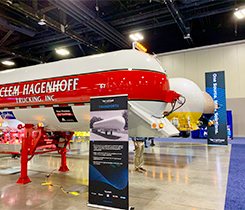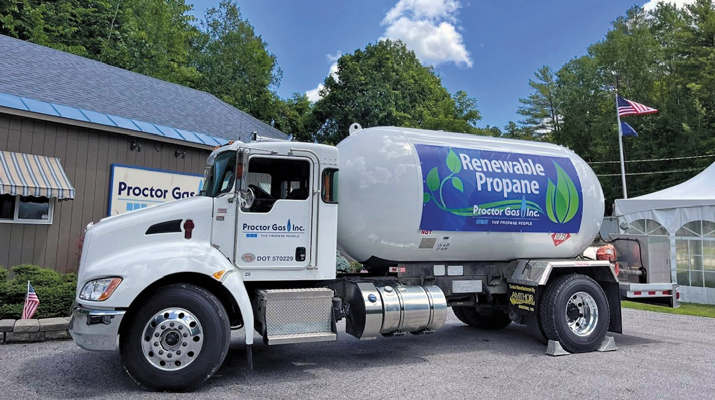Refurbish, revitalize and reuse
Tank refurbishing is becoming a popular option for propane marketers looking to beat the high cost of new storage and turn idle assets into productive settings for residential customers.
 |
Steel prices continue to hover near record high prices set more than a year ago, when raw material costs surged amid a red-hot worldwide steel market and jacked up the price for storage vessels of all sizes. A new, 500-gallon, above-ground tank that sold for $600 in 2003 skyrocketed to $900. Heading into the current heating season, that same tank continues to cost over $900, possibly over $1,000.
Meanwhile, more and more residential customers are looking to trade in their unsightly 250- or 500-gallon tank for a more aesthetically pleasing underground model. The growing trend over the last five years has left marketers with thousands of dollars of unused tanks in their yard inventories.
It didn’t take tank manufacturer American Welding & Tank long to figure out they could benefit from the scenario and provide an industry service by refurbishing old tanks to a near-OEM condition.
The Pennsylvania-based company saw an opportunity to offer a service to place those assets back into service on a national scale. Company officials knew it would take nationwide transportation resources, strategically located regional plants and the ability to provide the latest bar-coding technology for inventory tracking to fulfill the task, and AWT’s four regional manufacturing facilities fit the bill.
“As we considered the refurbishment opportunity, it was apparent that American Welding & Tank has access to all of these resources plus OEM-compliant paint systems, tank repair capabilities and production processes to provide vacuum-purged, refurbished tanks,” says Jim Alderman, manager, national sales administration.
 Refurbishing begins with a de-scaling process that brings the tank substrate to a near white condition. |
“Further, our nationwide truck fleet can readily collect the tanks for return to our nearest factory for reconditioning.”
Generally, tank refurbishing is done by taking an old tank and using a de-scaling process that brings the tank substrate to a near white condition. The tanks are then repainted and all valves are replaced.
The good-as-new tanks then go back to work, saving propane retailers about one-third the cost of new tanks.
According to Ted Reilly, AWT director of sales and marketing, surface preparation is the most critical element in refurbishing. AWT uses the same equipment that it uses to build new tanks to de-scale old paint and other materials prior to finishing the refurbished tanks with an OEM-applied coating. The vacuum-purged, refurbished tanks come with a one-year warranty on the coating.
AWT also has a nationwide fleet of trucks that enables them to pick up a tank in any part of the country, refurbish it, and return the finished product to the owner.
 Once the de-scaling process is complete, valves are replaced and the tank is repainted. The only thing not replaced is the steel. |
“Many national and regional marketers have found this an attractive and cost-effective way to re-deploy their propane tanks and return valuable idle assets back to service in an alternate region,” says Reilly.
All of AWT’s facilities carry the R-stamp certification required for any welding work done on the old tanks. That certification enables AWT to convert qualified aboveground tanks to the popular aboveground/underground (AG/UG) style units.
All tanks refurbished by AWT must contain less than 5 percent of product and have an attached dome, or be empty with a valve hand tight. All tanks must have a legible data plate attached, and be inspected for excessive pitting or dents beyond industry guidelines.
Tanks not manufactured by AWT or Chemi-trol and requiring weld repair or conversion must have a U1A Data Report, a national Board Strip Attached and a data plate specifying material used in tank construction.
Marketers can consolidate tanks at one location with a bill of lading that lists the tanks, their sizes and serial numbers. Some assistance to load the truck and confirm quantity, sizes and serial numbers of tanks loaded is requested.
 Propane marketers with old, excess tanks lying around can now consider refurbishing — and renew idle assets. |
“I believe the underground tank has provided the propane industry with a huge growth opportunity to participate in the energy decisions of contemporary housing developments,” says Alderman.
AWT initiated the pilot program for their tank refurbishing service in the second quarter of 2004. Don Fabricy, AWT vice president of sales and marketing, said they underestimated the demand for this service in the nationwide propane community.
Still, despite seemingly obvious benefits, tank refurbishing hasn’t become an industry trend, according to Fabricy.
“I don’t see it as a trend,” he says. “We are the only OEM to provide both refurbishing services and pre-owned tanks.”
Several other tank companies – including Trinity, Manchester, Worthington Cylinders and Liberty Tank & Vessel – don’t partake in the refurbishing market.
 When looking at the rising costs of steel and fuel, a refurbished and repainted tank becomes a pretty nice alternative. |
“We have periodically looked at the possibility of refurbishing,” says George Stoe, president of Worthington Cylinders. “We have always decided against it because of margins and the logistics and safety issues of working with tanks that might still contain residual gases.”
The high cost of transportation have made it too costly for Liberty to truck old tanks to its plants in Mexico and return them to the customer, according to Greg Perasso, president of the Northwest and Southwest regions for Liberty Tank & Vessel.
“The big issue affecting tank prices today is the diesel fuel cost to the transportation companies,” says Perasso. “We have gone from an already high 20 percent fuel surcharge levied by transportation companies to an above 30 percent fuel surcharge.”
Retail diesel fuel hit an all-time record high average of of $3.348 per gallon in mid-October, according to the U.S. Energy Department. Diesel is 96.8 cents higher than a year ago, while gasoline’s price is 69 cents higher than the same week last year. Diesel spiked a record 34.6 cents on Oct. 3 to reach a then-record $3.144 a gallon.
In dollars and cents, Perasso says the cost per mile to ship tanks to California has gone from $1.75 plus the 20 percent (36 cent) fuel surcharge to $2.35 per mile with a 34 percent (60 cents) fuel surcharge.
Additionally, shipment of tanks from the manufacturers to the west and east coasts have increased about $1,000 in 2005 due to freight increases, according to Perasso. On average, there are 45 tanks per truckload, putting the cost per tank at $22 higher than last year due to freight cost alone.
Most manufacturers include the cost of shipping into the delivered price of their tanks. Propane marketers do not see a separate freight bill, but do pay for the fuel surcharge increases with higher prices on tanks delivered to their location.
“Add the steel cost increase to the transportation cost increase and on average, a 250-gallon propane tank delivered to a propane marketer costs over $100 more than it did at the beginning of 2004,” says Perasso.
Besides soaring fuel and transportation costs, the ever-fluctuating steel prices have hammered the tank market. Even though steel prices have leveled off the past six months and there has not been a significant increase seen since last April, Perasso says many marketers with an inventory of old tanks are looking to better utilize their existing tank assets.
“Last year, the rapidly escalating prices for steel presented a problem for the industry,” says Worthington’s Stoe. “Prices have receded and although they are inching upward it is nothing like the meteoric rise we saw through 2004.”
Still, propane marketers are looking to bring large, underutilized tanks in from the field and replace them with smaller, refurbished tanks from their inventory. The larger tanks can then be re-set at higher volume locations.
“This evaluation of the proper utilization of tank assets should have been done anyway by propane marketers, but typically was overlooked until their new tank purchases increased over 25 percent,” says Perasso.
















